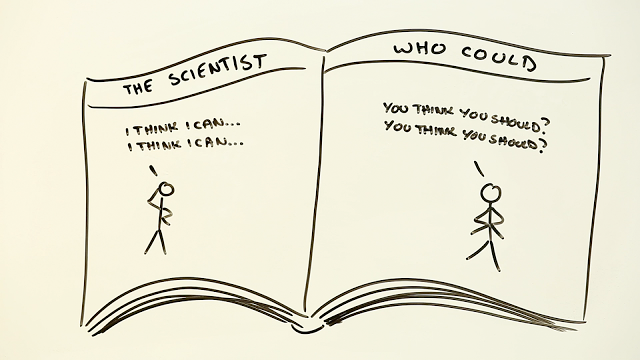The Pandora's Box of Gene Editing Is Now Open
 Kim BellardThe age of gene editing is upon us. Specifically, the use of CRISPR. Amazing things are happening, proving again how clever humans are. Whether we're smart remains to be seen. For those who are unfamiliar with it, CRISPR -- more accurately, CRISPR-Cas 9 -- is a new technique for gene editing. It has allowed faster, more precise, and less expensive gene editing. It can already do more than you may realize.
Kim BellardThe age of gene editing is upon us. Specifically, the use of CRISPR. Amazing things are happening, proving again how clever humans are. Whether we're smart remains to be seen. For those who are unfamiliar with it, CRISPR -- more accurately, CRISPR-Cas 9 -- is a new technique for gene editing. It has allowed faster, more precise, and less expensive gene editing. It can already do more than you may realize.
CRISPR has been much in the news lately, due to a new study published in Nature. Researchers successfully corrected a DNA mutation that causes a common heart disease that is sometimes fatal, especially for young athletes. In what is believed to be a first, the researchers repaired viable embryos. Moreover, they repaired most (72%) of the embryos, which is much better than previous efforts.
The mutation would have been fixed not only for the individual but also for their descendants.
The results produced some surprises. For example, of the 42 embryos where the mutation was corrected, 41 of them corrected it using the mother's (correct) version of the gene, rather than the inserted template DNA. That was not expected, and points to the unknowns involved in the process.
There are several important caveats. These were embryos in a lab, not a womb. They were not then implanted to verify that the embryos were viable. There were only a few dozen embryos, which did not have the trillions of cells that even an infant would have. And, perhaps most importantly, the researchers focused on a single mutation.
As Dr. Izpisua Belmonte, one of the researchers, told The Washington Post, "I don’t want to be negative with our own discoveries, but it is important to inform the public of what this means. In my opinion the percentage of people that would benefit from this at the current way the world is rather small."
Most diseases, physical characteristics, talents and traits are genetically complex, involving numerous genes (height, for example, may involve 93,000!), and so are not easily amenable to this approach. Still, some 10,000 medical conditions are believed to be caused by specific mutations, including Huntington's disease, cystic fibrosis, and sickle cell anemia.
Robin Lovell-Badge, a professor of genetics at London's Francis Crick Institute, told The New York Times, "You could certainly help families who have been blighted by a horrible genetic disease. You could quite imagine that in the future the demand would increase. Maybe it will still be small, but for those individuals it will be very important.”
The research team has already said that the BRCA gene mutation, associated with breast cancer, may be one of their next targets.
Despite this, there were articles about this being the prelude to "designer babies," as well as more balanced articles about why that was not true -- yet. Alta Charo, a professor of law and bioethics at the University of Wisconsin, told The Atlantic: "This has been widely reported as the dawn of the era of the designer baby, making it probably the fifth or sixth time people have reported that dawn. And it's not."
The researchers and many others are keenly aware of the ethical issues involved. The Executive Director of the Center for Genetics and Society warned about people being willing to pay for genetic upgrades:
Once those commercial dynamics kick in, we could all too easily find ourselves in a world where some people’s children are considered biologically superior to the rest of us. We need to ask ourselves whether we want that new kind of excuse for extreme social disparities we already tolerate.
In many countries, there are restrictions on this kind of research. 15 out of 22 Western European counties, as well as Canada, ban attempts to change the human germline. In the U.S., federal funding is not allowed, nor are clinical trials, but other research is permitted, under some voluntary guidelines.
Shoukhrat Mitalipov, one of the lead researchers in the recent study, hopes there will soon be some consensus on how to regulate the field, as otherwise, "this technology will be shifted to unregulated areas, which shouldn’t be happening." There is an international summit on gene editing scheduled for early 2018 in China.
China is already a leader in the field.
The technique has made tremendous progress in just a few years, and it is going to make even more in the future. However, we're going to find that directed changes to our genome are even harder than we suspect.
But they are going to happen. We can use technology for good or for bad, but history has taught us that, once developed, we will use it, one way or another. CRISPR and whatever comes next in gene manipulation will be no exception.

There are several ways this could go:
- We walk before we run: We could first focus on single mutation diseases, figuring out how to prevent them from occurring, possibly even reversing them. Only then carefully move to more complex conditions.
- We widen inequality: We already know that more money means better health and a longer life. Genetic engineering could drastically further widen all of these inequalities -- permanently. Remember Brave New World?
- We weaponize it: We know China is working on gene editing. Who knows what North Korea or Iran is doing. If a country could create smarter, stronger, more creative citizens, they'd have an economic or even military advantage. If used on other populations, it could make chemical or biological weapons seem trivial. It has already been called a potential weapon of mass destruction.
- We goof: We are just beginning to really understand the complex interplay of genes, their environment, and other factors, not to mention the impact that our microbiome -- whose genes vastly outnumber our own -- has on us. We're going to have more surprises, and they may not all be good As Kevin Esvelt, a prominent researcher in the field, has admitted: "My greatest fear is that something terrible will happen before something wonderful happens."
The Pandora's Box of gene editing is now open. We have high hopes for it, but we should remember that, in the original parable, hope was the last thing in the box, not the first.
Let's hope we're smart about it.
| The Pandora's Box of Gene Editing Is Now Open was authored by Kim Bellard and first published in his blog, From a Different Perspective.... It is reprinted by Open Health News with permission from the author. The original post can be found here. |
- Tags:
- Alta Charo
- BRCA gene mutation
- breast cancer
- Center for Genetics and Society
- China
- correcting DNA mutation
- CRISPR
- CRISPR-Cas 9
- cystic fibrosis
- Francis Crick Institute
- gene editing
- healthcare ethics
- healthcare innovation
- Huntington's disease
- Izpisua Belmonte
- Kim Bellard
- London
- Robin Lovell-Badge
- Shoukhrat Mitalipov
- sickle cell anemia
- Login to post comments
